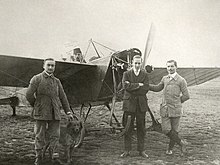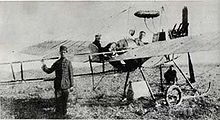Ottoman Aviation Squadrons
| Military of the Ottoman Empire |
|---|
 |
The Ottoman Air Force was founded in June 1909, making it one of the first combat aviation organizations in the world. Its formation came about after the Ottoman Empire sent two Turkish pilots to the International Aviation Conference in Paris. It was the predecessor of today's Turkish Air Force.
Establishment


After witnessing the growing importance of an air combat support branch, the Ottoman government decided to organize its own military aviation program. For this purpose officers were sent to Europe by the end of 1910 to participate in the study of combat flight. However, because of bad living conditions, the student program was aborted and the trainees returned to Turkey in the spring of 1911.
Although left without any governmental guidelines for establishing an air force, the Ottoman Minister of Defence of the time, Mahmut Şevket Paşa, continued to encourage the idea of a military aviation program and sent officers Fesa and Yusuf Kenan, who achieved the highest maneuvering points in a piloting test conducted in 1911, to France for receiving a more satisfactory flight education.
In late 1911 Süreyya Ilmen was instructed with founding the Havacılık Komisyonu (Aviation Commission) bound to the Harbiye Bakanlığı Fen Kıtaları Müstahkem Genel Müfettişliği (War Ministry Science Detachment General Inspectorship). A "Tayyare Istasyonu ve Mektebi" (flight station and school) was started on June 1, 1911 at Yeşilköy.
On February 21, 1912, Cavalry Captain Fesa (Evrensey) and Lieutenant Yusuf Kenan completed their flight education at the Blériot flight school in Paris and returned home with the 780th and 797th French aviation diplomas. In the same year, eight more Turkish officers were sent to France for flight education.
The Ottoman Empire started preparing its first pilots and planes, and with the founding of the Hava Okulu (Air Academy) in Istanbul on July 3, 1912, the empire began to tutor its own flight officers. The founding of the Air Academy quickened advancement in the military aviation program, increased the number of enlisted persons within it, and gave the new pilots an active role in the Armed Forces.
Same year a single-seat and a two-seater Deperdussin airplanes were purchased from France and brought over to Istanbul in March 1912. Two of the two-seater version of Bleriot XI-b were also acquired, first of which was presented by Supreme Commander Rıza Paşa. Three of a different two-seat model named XI-2 and three of the single-seat model called Pengouin were also deployed at the Ottoman Armed Forces.
In accordance with the agreement reached in between the producer and the Ottoman Ministry of War, 7 REP, Robert Esnault-Pelterie[1] planes were also purchased and the first one was planned to join Ottoman Armed Forces on March 15, 1912, The enthronement anniversary of Sultan Reşad (Mehmet V.)
By the end of 1912, the Ottoman Air Force had a total of 15 machines, acquired mostly through private donations.
In May 1913 the world's first specialized Reconnaissance Training Program was activated by the Air Academy and the first separate Reconnaissance division was established by the Air Force.
Italo-Turkish War

In 1911, Italy invaded the Ottoman colony of Libya (Italo-Turkish War), using aircraft for reconnaissance and bombing. This was the first time in history where airplanes (and drigibles)bombed ground targets in war. In return, Ottoman troops were the first in history to bring down a warplane and capture its pilot.
Balkan Wars
After the North Africa campaing against Italy, the Ottoman Air Force saw action on another front in the First Balkan War, against the Balkan countries of Montenegro, Serbia, Bulgaria and Greece. Seventeen Ottoman aircraft were used for reconnaissance, from September 1912 to October 1913. The Ottoman Air Force, in its inexperience, lost several airplanes at first; as they hardened to battle, they improved and there was a swarm of recruits to the new force.
Nevertheless, the Balkan League won the war. A short while later, Bulgaria attacked Serbia to kick off the Second Balkan War, and Turkey pitched in on the Serbian side.
By the end of the Balkan Wars, the fledgling Ottoman Air Force had already been through three wars and a coup d'état.
With the end of the Balkan Wars a modernization process started and new planes were purchased. With the outbreak of the First World War, the modernization process stopped abruptly.
World War I Structure and Organization
The Ottoman Air Force began World War I under direct control of the Başkomutanlik Vekaleti (Office of the Supreme Military Command). Because of the cost of aircraft, it was a small unit. It would remain there for the duration of the war, never becoming a separate corps as in other World War I armies. Instead it was parceled out in small detachments to an army or corps which directed tactical use of the planes. Primitive logistics kept the units small.
To complicate matters, the navy established its own air academy, the Deniz Hava Okulu, in Istanbul in June 1914.
In 1915 some German officers came to the Ottoman Empire and some Turkish officers went to Germany for flight education.
By the end of 1915, two offices were established to govern aviation. The 13th Branch was part of the Turkish General Staff; the 9th Branch was part of the Minister of War's office. Although the 13th Branch was senior to the 9th, opportunities for overlap and turf battles were legion.
By 1916, the growing air force had 81 pilots and observers and about 90 planes. Eventually, Germany would transfer 460 planes into Turkey; some 260 went to the Ottoman Air Force and the rest remained in German units. Some 400 German aviation personnel served in Turkey.
By war's end, the Ottoman Air Force was a potpourri of about 200 supplied, purchased, and captured aircraft from Germany, France, Russia, and Britain. Even a general enumeration is overwhelming: seven types of Albatros; four types of Fokkers; three types of Gotha bombers; two types each of Rumpler and Caudron; plus LVG B series, Halberstadts, Pfalzes, Voisins, DeHavillands, Nieuports, a Bristol Bullet, a Farman, a Morane-Saulnier L Parasol, and a Grigorovich G.5.
Efforts were made to reorganize the Ottoman Air Force, but this ended in 1918 with the end of the First World War and the occupation of Istanbul.
World War I Operations
The Ottoman Air Force fought on many fronts during the First World War, from Galicia in the west to the Caucasus in the east and Yemen in the south.
In the beginning of the war, one account says it had eight planes assigned for operations and four in the Yesilkoy flying school on the outskirts of Istanbul; of six operational planes, two were sent to eastern Turkey, with the others retained at the flying school. Another account insists the Turks had only five aircraft and six pilots.
Oberleutnant (First Lieutenant) Erich Serno of the German Air Force arrived in January, 1915, accompanied by a staff of twelve. These men were parceled out to Ottoman detachments to fill out shortages in trained Turkish personnel. Other German air personnel were later supplied. The augmentation became so extreme that one of the seven detachments formed by the end of 1915 was wholly German, although they wore Ottoman uniforms. Total Turkish personnel in these seven detachments were 11 observers and seven army pilots, three navy pilots, and three civilian pilots.
The most important 1915 operation of the Ottoman Air Force was the surveillance of the Gallipoli landing. This was performed by the two detachments.
A Turkish first would be the use of aircraft against the Arab revolt instigated by T. E. Lawrence beginning in 1916; it was the first use of airstrikes against guerrillas.
In summer 1918, Royal Air Force units in Palestine pressured the Ottoman Air Force out of its reconnaissance role. The Turks, lacking the information to fend off Allenby's offensives around Megiddo, found themselves under heavy air attack while retreating from their rout. This was probably the first time in history an army had suffered this.
After the War
With the end of the First World War and the occupation of the Ottoman Empire, the Ottoman Air Force was nothing more than a department. All personnel, including pilots and teachers, were either relieved of duty or disbanded, and all Air Force governmental buildings were closed. Some optimistic Turks tried to build new units in Istanbul, İzmir, Konya, Elazığ and Diyarbakır with planes left over from the First World War and tried to bring together flight personnel, but were unsuccessful.
During this period, the Turks in Anatolia were roused and ready to fight for their independence and motherland under Mustafa Kemal Atatürk. Turkish pilots were ready to do this, too, and subsequently joined the Konya Hava Istasyonu (Konya Air Station). Parallel to this, however, the Ottoman Air Force was closed by the Ottoman Ministry of War and all personnel were formally discharged. The Ottoman pilots were thus left without planes and proper assistance and this early period of Ottoman Aviation ended.
Birth of the Turkish Air Force
With the opening of the Grand National Assembly in 1920 in Ankara, the reorganization of an ordered Army, the Kuva-yı Havaiye Subesi (Air Force Branch) bound to the Harbiye Dairesi (Ministry of War bound to the TBMM) was found. A few damaged aircraft belonging to the Grand National Assembly were repaired, and afterwards used in combat.
In 1921, the Hava Kuvvetleri (Kuva-yı Havaiye) Şubesi air force section was renamed as Hava Kuvvetleri Genel Müdürlüğü, or the Air Force General Command. This was the beginning of the Turkish Air Force.
References
- http://www.onwar.com/aced/data/bravo/balkan1912.htm Accessed 2 October 2008.
- http://www.incirlik.af.mil/library/factsheets/factsheet.asp?id=5470 Accessed 2 October 2008.
- http://www.infoplease.com/ce6/history/A0805909.html Accessed 2 October 2008.
- http://flagspot.net/flags/tr%5Eairf.html Accessed 2 October 2008.
- Ordered to Die: A History of the Ottoman Army in the First World War. Edward J. Erickson. Greenwood Publishing Group, 2001.
- Coalition Warfare: An Uneasy Accord. Keith Neilson, et al. Wilfrid Laurier University Press, 1983.
- The Arab Revolt 1916-18: Lawrence set Arabia ablaze. David Murphy. 2008.
Footnote
- ^ The REP, Robert Esnault-Pelterieare also one the first planes deployed at the Turkish Air Force or “The Supreme Ottoman Armed forces” as it was called in those days. The plane was designed by Robert Esnaoult-Pelterie and its first flight took place in 1912 and they entered service during the same year in France. In accordance with the agreement reached in between the producer and the Ottoman Ministry of War 7 REP planes were also purchased and the first one was planned to join Ottoman Armed Forces on March 15, 1912, The enthronement anniversary of Sultan Reshad (Mehmet V.) Five of the seven purchased were single seaters and the remaining two were two-seaters. One of the single seaters were planned only for ground practicing. The last plane was confiscated by the Serbians while being brought to Istanbul by train. These primitive planes were already out of service by 1914.
